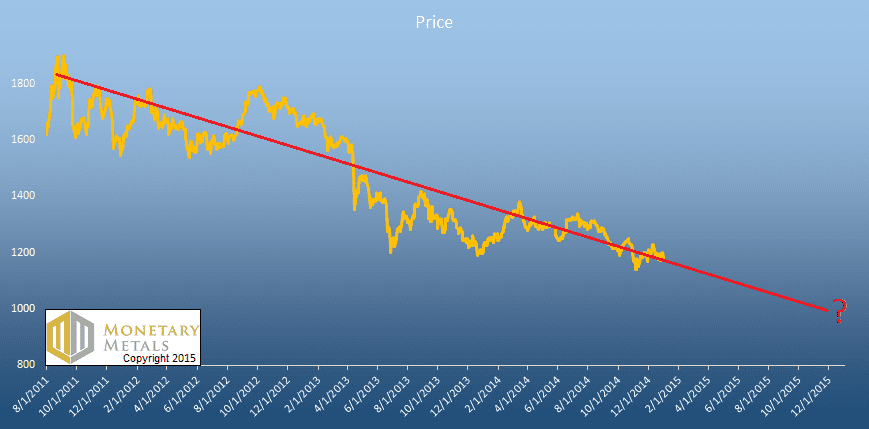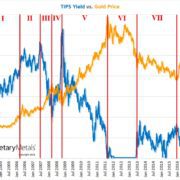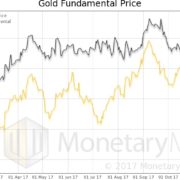Monetary Metals Brief 2016
We have consistently been making the contrarian call for a falling silver price and a rising gold to silver ratio for years. This ratio has risen a lot during this time. So are we ready to change our call yet?
Review of Our Call in 2015
Let’s hold ourselves accountable for what we said last year in our Outlook 2015: “There is currently no evidence that scarcity is rising, and thus gold should shoot da moon.” Our bottom line recommendation was, “To those looking to trade, at the moment this report is published you might buy gold for a quick trade. There is no case to buy silver.” We added, “We see no rush to load up the truck just yet.” We said the likely driver for a higher price would be deteriorating credit conditions.
How did we do with these calls?
The gold price has not yet risen to meet our fundamental price. The price was basically down all year after a blip in January. Our silver call turned out to be conservative. Silver closed the year at $13.84, which was below even our number.
Our call on the gold-silver ratio was in the right direction, though the market did not move a lot. It went up about 1.6%.
How Not to Think about Gold
There are several popular approaches to analyzing gold but the most popular is the conventional commodity analysis of annual supply and demand figures. However, gold cannot be understood by looking at small changes in production or consumption.
This is because virtually all of the gold ever mined in human history is still in human hands (to a somewhat lesser extent for silver). No other commodity comes even remotely close. The US Geological Survey estimated the total gold stocks at 171,300 metric tons at the end of 2011. Annual production is just 1.6% of these stocks. In other words, it would take 61 years at current production levels just to produce the same amount of gold as is now stockpiled. In regular commodities, this same ratio—stocks to flows—is measured in months. We just don’t hoard wheat and oil for the long term, for obvious reasons. Nor even iron or lumber or other durable materials.
If total gold mining is 1.6% of gold inventories, then small changes to that 1.6% are not likely to have much impact on the gold price.
How We Think About Gold
The implications of this are extraordinary.
All of that stockpiled gold represents potential supply, under the right market conditions and at the right price. Yet there is never a glut in gold. Through thick and thin, through rising and falling prices, for thousands of years, the market goes on hoarding and absorbing whatever the miners put out.
Conversely—unlike ordinary commodities—virtually everyone on the planet represents potential demand. Why? Because gold and silver are money. Compare gold to oil. The marginal utility of oil—the value one places on the next barrel compared to the previous—declines rapidly. For oil, it falls rapidly because once your tank is full, you have a storage problem—assuming you even use oil at all.
However, the marginal utility of gold hardly declines at all. People are happy to get the 1,001st ounce, and accept it on the same terms as the 1,000th or the 1st ounce.
We therefore think that changes in the desire to hoard or dishoard gold have a big impact on price and are more important than small changes in annual supply and demand flows.
How We Analyze the Gold Market
As a result, we think of the market as the coming together of 5 different primary groups.
- Buyers of metal, typically hoarders. Unlike buyers of other commodities, they don’t have to incorporate it into a product and sell it to make a profit. So there is no particular price that is necessarily too high, other than whatever their notion of a fair price is at any given moment.
- Sellers of metal who are dishoarding. They may think the price has hit a high enough level to attract their greed, or a low enough level to activate their fear.
- Buyers of paper (e.g. futures). These are speculators, with three key differences from buyers of metal. One, they use leverage. Two (for that reason and others) they have a short time horizon. Three, their exclusive goal is to make a trade for dollar gains.
- Short sellers of paper. Not nearly so big a group as popularly imagined, there are people who take the two lopsided risks of (1) shorting something with limited profit and unlimited loss potential and (2) fighting a 100-year trend. These people are nimble and aggressive and certainly play for the short term.
- Warehousemen, aka market makers. If few people are willing to bet on a rising dollar (i.e. falling gold price), then who sells gold futures? Enter, the warehouseman, who stands ready to carry gold for anyone who wants future delivery. If you buy a future, you are signaling that you want gold, not to be delivered now, but at some date in the future and this group will sell it to you by buying metal in the spot market and simultaneously selling a contract for future delivery. They don’t care at all about price, as they have no exposure to price. They respond to spread.
While virtually all of the gold ever mined is in someone’s hoard and thus there cannot be such a thing as a glut or shortage, the market can experience relative abundance and scarcity and the spreads of the warehouseman provide a good signal to see it.
If there is a big spread, such as in our example in #5, that means two things. One, speculators are bidding up futures contracts. And two, the marginal use of gold is to go into the warehouse. This is a sign of abundance.
Normally, the price in the futures market is higher than the price in the spot market – called contango. Contango means it is profitable to carry the metal, which is to buy a metal bar and sell a future against it. However, the spread can invert and it has many times since the crisis of 2008. When it is inverted—called backwardation—it is profitable to sell metal and buy a future. Incentives to decarry metal should never happen in gold, as it is a sign of shortage and there is no such thing as a shortage in a metal which has been hoarded since ancient times. In backwardation, the marginal supply of metal is coming from the warehouse (carry trades are unwinding) but there is only a finite supply of gold held in carry.
This is the only way to analyze supply and demand fundamentals for the monetary metals: studying spreads between spot and futures, and changes to these spreads, to understand the constantly changing interaction of these five market participants (see here for more on our approach).
Our Call
For a few years, the market had been in a mode of soft to declining fundamentals for both monetary metals. In 2015, the fundamentals of gold firmed up though silver continued the same trend. There are, of course, price blips. In each blip, we see the same pattern repeated. As price goes up, abundance of the metal rises. Scarcity declines. Then the price subsides and the abundance drops again. It is a pattern of speculators testing the market to see if it has the magic go-juice.
For over three years, we have been calling this publicly. On every silver price blip, a chorus of voices from the precious metals community has cried “break out!” But it has not been so. We have been publishing our data, and our analysis. “This is not the break out you’re looking for,” quoth us (paraphrasing from Obi Wan Kenobe in Star Wars).
Needless to say, this is not the behavior of a silver market price that is shooting, or signaling that it will soon shoot, higher. So what is the outlook for silver, and gold, in 2016?
As of year’s end 2015, the Monetary Metals fundamental price of gold is $1,246. For silver, it is $14.20. That puts the gold-silver ratio at around 88.
There is so much more to say. Read the full Monetary Metals Outlook 2016 (free registration required). We explore in-depth the points made above. We provide a detailed look at the collapse of commodities, threat of deflation, debt crisis, the dollar, interest rates, the quantity of money and what it all means for gold and silver in 2016.
© 2016 Monetary Metals LLC. All Rights Reserved.






Keith,
I have been following precious metals for 40 years and 28 of those years as a Stock-Broker.
I am now an Author and Consultant on Convertible Bonds.
This is about the best and the easiest article that I have ever read.
Bravo and THANKS.
Best regards,
Yvon
I understand the argument. However, when financial interests dominate the market (that is, the number of contracts are multiples of the underlying stream of physical goods) one can have situations where the tail is wagging the dog. This does in fact happen, and financial interests (speculators) have been known to actually enter the physical trade, buying up storage facilities and moving around goods (to make it appear as if they are being traded) just to make it appear that physical shortages are real, in an attempt at passing their losses on to other parties and consumers. Or even buying controlling interest in physical production to artificially control supply. There are good reasons why there is market regulation that attempts to halt anti-competitive/ monopoly manipulation and anti-trust legislation: parties have in the past been able to control supply or made supply/demand to appear other than it is (fraud).
This is the argument of all the precious metals bugs, who are convinced that financial interests have stepped into the role of the warehouseman and artificially control the apparent (seeming) fundamentals. That in fact they are playing the same game as fractionally-reserved banks who hope that there will not be a run on the money they don’t have, and, in fact, have put many mechanisms into place to be able to suppress (locally and temporarily — divide and conquer) any dislocation as it arises, hoping they can pre-empt aggregated runs, even enjoining the powers of the state in their efforts.
I don’t think you have adequately dispelled this popular angle on the markets: The counter-parties (banks) are operating with credit instead of money/metal and thus have almost unlimited resources with which to manipulate appearances in the short-term, long enough to smoke out the people who are operating under limited constraints (in terms of credit, concerted action, and behind the scenes information).